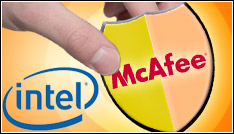Intel Officially Completes McAfee Acquisition

McAfee is to retain its own branding, but will become a wholly owned subsidiary of chip giant Intel
Intel has now completed its $7.68 billion (£4.7 billion) acquisition of data-security specialist McAfee, announced in August 2010.
The move now clears the way for McAfee security features to be integrated directly into Intel processors.
As is common to global companies, Intel had to clear federal (Securities and Exchange Commission and Federal Trade Commission) and international hurdles – including approval from the European Union antitrust committee – to secure the deal.
Retains Branding
Under the terms of the merger agreement, McAfee will become a wholly owned subsidiary of Intel and continue developing and selling security products and services under its own brand.
 Intel and McAfee said they plan to bring the first product results of their partnership to market later in 2011, with the intent of tackling security and the pervasive nature of computing threats in an entirely new way.
Intel and McAfee said they plan to bring the first product results of their partnership to market later in 2011, with the intent of tackling security and the pervasive nature of computing threats in an entirely new way.
The deal was questioned at first by industry analysts as to whether it would be a good fit because of Intel’s spotty track record in acquiring companies not directly related to processor making.
Forrester Research analyst Andrew Jaquith pointed out a couple of examples to eWEEK reporter Brian Prince back when the acquisition was announced.
“In 2005, Intel bought Sarvega, a hardware-and-software play in the XML-processing segment,” Jaquith explained. “Today, it is irrelevant. In 1991, Intel bought LANDesk as the centerpiece of its DMTF [Desktop Management Task Force] strategy … LANDesk was sold at the height of the dot-com boom, and it has been bought, spun off or sold three times again. Now Intel wants to get back in the software game again. Again, how will this be any different?”
Steve Coplan, an analyst with The 451 Group, told Prince that Intel’s software division has long been an “orphan child” to the hardware division, despite the division’s generating significant revenues.
Challenges Ahead
“The strategic impetus here is to inorganically grow software revenues and elevate its visibility across the industry … Security should ideally be an integrated element of systems and networks, and Intel has the opportunity to emerge as a mobile firmware player with a reach into the desktop and server world,” he said. “McAfee was one of the few vendors with a discrete security focus and the run rate that would move the dial.”
Gartner analyst Neil MacDonald said Intel needs to figure out how to build an established sales force to sell to enterprises.
“That’s one challenge,” he said. “Another challenge is that … in the network buying centre, which is a good chunk of McAfee’s business, they don’t think of Intel at all…So for Intel to target that market, that’s very difficult to bridge that gap in buying centers. McAfee has successfully done that, but the challenge is Intel doesn’t really add anything to that mix.”
Intel and McAfee executives have said that conventional approaches to security do not adequately address billions of new Internet-ready devices, including PCs, mobile and wireless devices, TVs, cars, medical devices and ATM machines.
New Approaches
With the continuing surge in cyber-threats, providing protection to diverse online devices requires a fundamentally new approach involving software, hardware and services, Intel said.
As a wholly owned subsidiary, McAfee now reports into Intel’s Software and Services Group. The group is managed by Intel Senior Vice President and General Manager Renee James. McAfee’s president, Dave DeWalt, will report to James.
“In the past, energy-efficient performance and Internet connectivity have defined computing requirements,” James said. “Intel has added security as a third pillar of what people demand from their experiences with personal computers and other connected devices.”
Editor’s note: This story includes previous reporting from eWEEK’s Brian Prince.